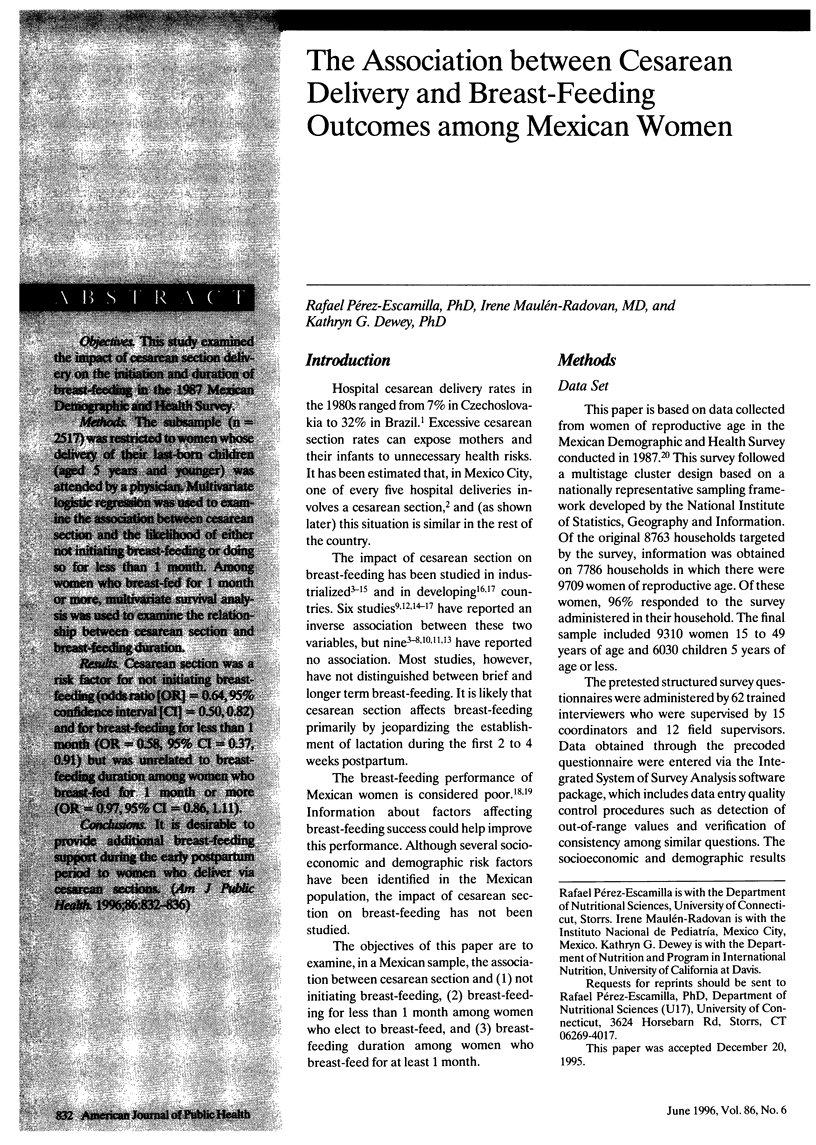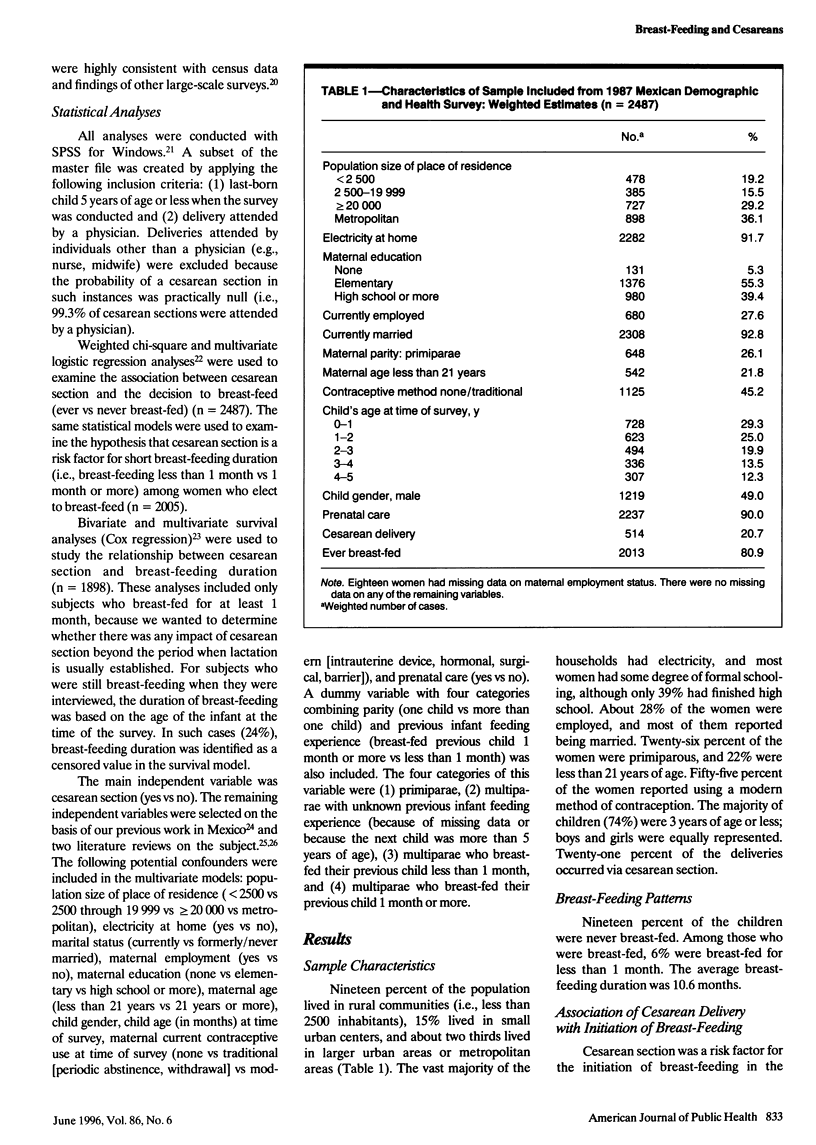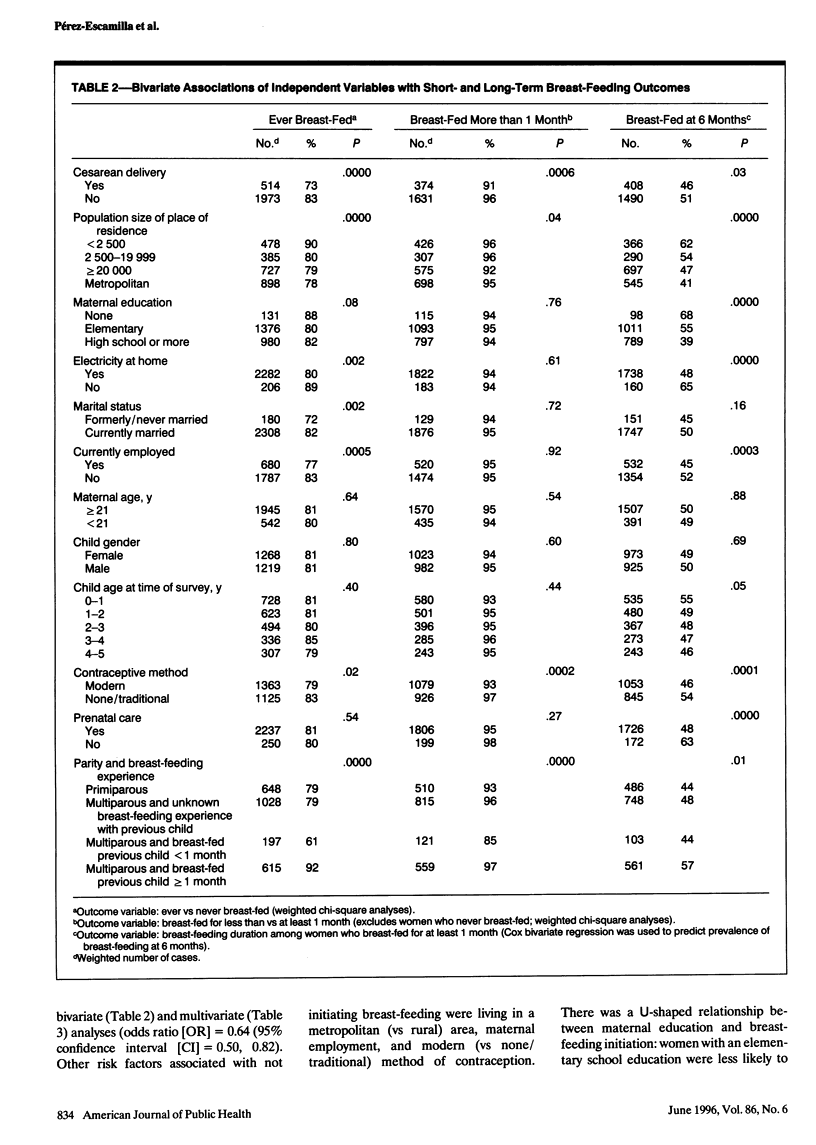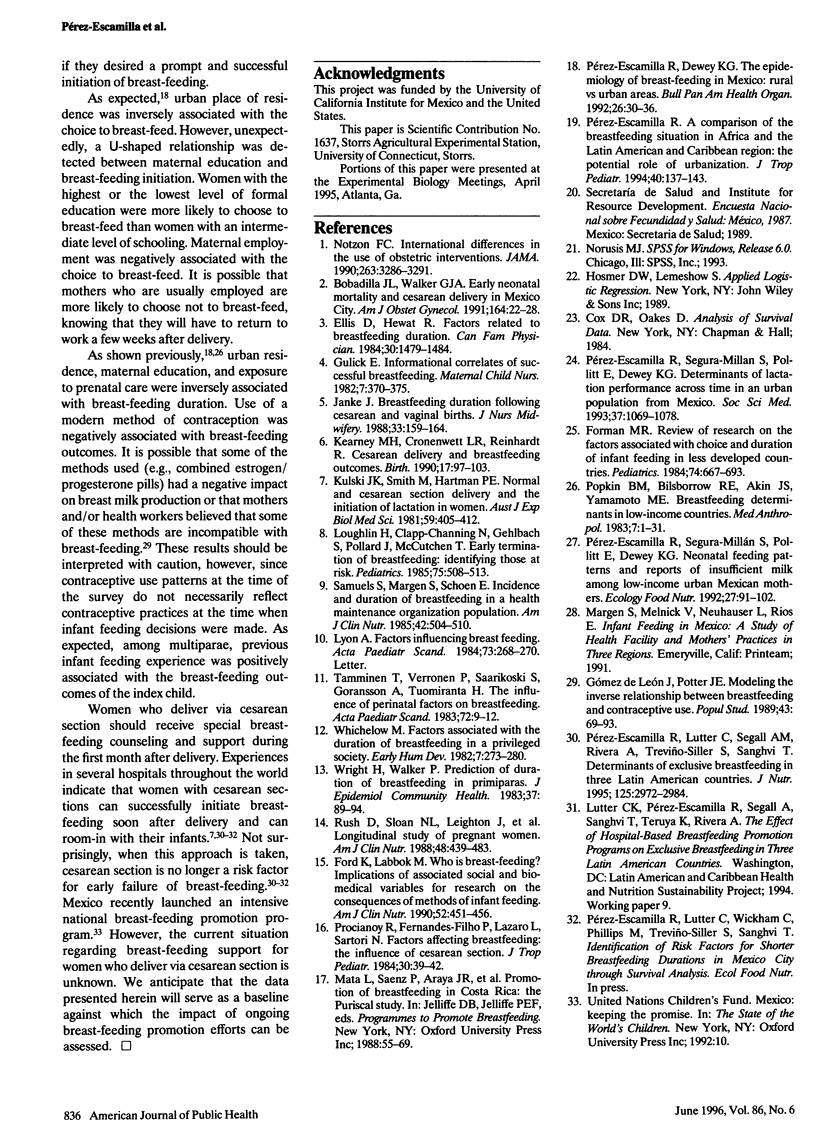Abstract
OBJECTIVES: This study examined the impact of cesarean section delivery on the initiation and duration of breast-feeding in the 1987 Mexican Demographic and Health Survey. METHODS: The subsample (n = 2517) was restricted to women whose delivery of their last-born children (aged 5 years and younger) was attended by a physician. Multivariate logistic regression was used to examine the association between cesarean section and likelihood of either not initiating breast-feeding or doing so for less than 1 month. Among women who breast-fed for 1 month or more, multivariate survival analysis was used to examine the relationship between cesarean section and breast-feeding duration. RESULTS: Cesarean section was a risk factor for not initiating breast-feeding (odds ratio [OR] = 0.64, 95% confidence interval [CI] = 0.50, 0.82) and for breast feeding for less than 1 month (OR = 0.58, 95% CI = 0.37, 0.91) but was unrelated to breast-feeding duration among women who breast-fed for 1 month or more (OR = 0.97, 95% CI = 0.86, 1.11). CONCLUSIONS: It is desirable to provide additional breast-feeding support during the early postpartum period to women who deliver via cesarean sections.
Full text
PDF




Selected References
These references are in PubMed. This may not be the complete list of references from this article.
- Bobadilla J. L., Walker G. J. Early neonatal mortality and cesarean delivery in Mexico City. Am J Obstet Gynecol. 1991 Jan;164(1 Pt 1):22–28. doi: 10.1016/0002-9378(91)90616-y. [DOI] [PubMed] [Google Scholar]
- Ford K., Labbok M. Who is breast-feeding? Implications of associated social and biomedical variables for research on the consequences of method of infant feeding. Am J Clin Nutr. 1990 Sep;52(3):451–456. doi: 10.1093/ajcn/52.3.451. [DOI] [PubMed] [Google Scholar]
- Forman M. R. Review of research on the factors associated with choice and duration of infant feeding in less-developed countries. Pediatrics. 1984 Oct;74(4 Pt 2):667–694. [PubMed] [Google Scholar]
- Gulick E. E. Informational correlates of successful breast-feeding. MCN Am J Matern Child Nurs. 1982 Nov-Dec;7(6):370–375. [PubMed] [Google Scholar]
- Janke J. R. Breastfeeding duration following cesarean and vaginal births. J Nurse Midwifery. 1988 Jul-Aug;33(4):159–164. doi: 10.1016/0091-2182(88)90186-3. [DOI] [PubMed] [Google Scholar]
- Kearney M. H., Cronenwett L. R., Reinhardt R. Cesarean delivery and breastfeeding outcomes. Birth. 1990 Jun;17(2):97–103. doi: 10.1111/j.1523-536x.1990.tb00708.x. [DOI] [PubMed] [Google Scholar]
- Kulski J. K., Smith M., Hartmann P. E. Normal and caesarian section delivery and the initiation of lactation in women. Aust J Exp Biol Med Sci. 1981 Aug;59(4):405–412. doi: 10.1038/icb.1981.34. [DOI] [PubMed] [Google Scholar]
- Loughlin H. H., Clapp-Channing N. E., Gehlbach S. H., Pollard J. C., McCutchen T. M. Early termination of breast-feeding: identifying those at risk. Pediatrics. 1985 Mar;75(3):508–513. [PubMed] [Google Scholar]
- Lyon A. J. Factors influencing breast feeding. Acta Paediatr Scand. 1984 Mar;73(2):268–270. doi: 10.1111/j.1651-2227.1984.tb09942.x. [DOI] [PubMed] [Google Scholar]
- Notzon F. C. International differences in the use of obstetric interventions. JAMA. 1990 Jun 27;263(24):3286–3291. [PubMed] [Google Scholar]
- Perez-Escamilla R. Breastfeeding in Africa and the Latin American and Caribbean region: the potential role of urbanization. J Trop Pediatr. 1994 Jun;40(3):137–143. doi: 10.1093/tropej/40.3.137. [DOI] [PubMed] [Google Scholar]
- Perez-Escamilla R., Dewey K. G. The epidemiology of breast-feeding in Mexico: rural vs. urban areas. Bull Pan Am Health Organ. 1992;26(1):30–36. [PubMed] [Google Scholar]
- Perez-Escamilla R., Segura-Millán S., Pollitt E., Dewey K. G. Determinants of lactation performance across time in an urban population from Mexico. Soc Sci Med. 1993 Oct;37(8):1069–1078. doi: 10.1016/0277-9536(93)90441-6. [DOI] [PubMed] [Google Scholar]
- Procianoy R. S., Fernandes-Filho P. H., Lazaro L., Sartori N. C. Factors affecting breastfeeding: the influence of caesarean section. J Trop Pediatr. 1984 Feb;30(1):39–42. doi: 10.1093/tropej/30.1.39. [DOI] [PubMed] [Google Scholar]
- Pérez-Escamilla R., Lutter C., Segall A. M., Rivera A., Treviño-Siller S., Sanghvi T. Exclusive breast-feeding duration is associated with attitudinal, socioeconomic and biocultural determinants in three Latin American countries. J Nutr. 1995 Dec;125(12):2972–2984. doi: 10.1093/jn/125.12.2972. [DOI] [PubMed] [Google Scholar]
- Rush D., Sloan N. L., Leighton J., Alvir J. M., Horvitz D. G., Seaver W. B., Garbowski G. C., Johnson S. S., Kulka R. A., Holt M. The National WIC Evaluation: evaluation of the Special Supplemental Food Program for Women, Infants, and Children. V. Longitudinal study of pregnant women. Am J Clin Nutr. 1988 Aug;48(2 Suppl):439–483. doi: 10.1093/ajcn/48.2.439. [DOI] [PubMed] [Google Scholar]
- Samuels S. E., Margen S., Schoen E. J. Incidence and duration of breast-feeding in a health maintenance organization population. Am J Clin Nutr. 1985 Sep;42(3):504–510. doi: 10.1093/ajcn/42.3.504. [DOI] [PubMed] [Google Scholar]
- Tamminen T., Verronen P., Saarikoski S., Göransson A., Tuomiranta H. The influence of perinatal factors on breast feeding. Acta Paediatr Scand. 1983 Jan;72(1):9–12. doi: 10.1111/j.1651-2227.1983.tb09655.x. [DOI] [PubMed] [Google Scholar]
- Whichelow M. J. Factors associated with the duration of breast feeding in a privileged society. Early Hum Dev. 1982 Dec 6;7(3):273–280. doi: 10.1016/0378-3782(82)90090-1. [DOI] [PubMed] [Google Scholar]
- Wright H. J., Walker P. C. Prediction of duration of breast feeding in primiparas. J Epidemiol Community Health. 1983 Jun;37(2):89–94. doi: 10.1136/jech.37.2.89. [DOI] [PMC free article] [PubMed] [Google Scholar]


